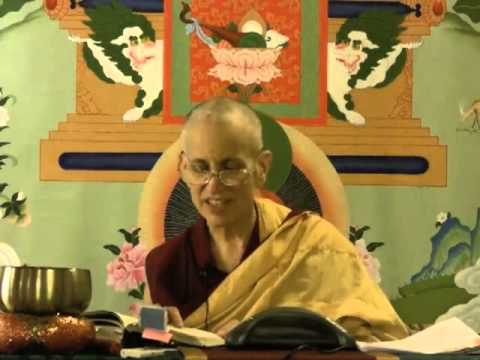Forgetting the object of meditation
The second of five faults to concentration
This talk was given during the White Tara Winter Retreat at Sravasti Abbey.
- When you can’t stay on your object of meditation
- Lack of mindfulness is forgetfulness
- Making a strong determination to put your mind on your chosen object of meditation
- Not being too tight
White Tara Retreat 30: Concentration fault of forgetting meditation object (download)
In speaking of the five faults for developing serenity, the second one is forgetting the object of meditation. What this means is that you can’t stay on your object of meditation. The antidote to that is mindfulness. Now, you might wonder why does it say “forgetting” the object of meditation? Well, the word mindfulness, or sati, actually means “to remember.” So a lack of mindfulness would be forgetfulness. It doesn’t just mean like: “Oh, I forgot that I’m meditating on White Tara.” It means when you sit down to meditate and you try and focus on your object of meditation (be it White Tara, or the breath, or whatever your object of meditation), that your mind doesn’t stay on it.
I think you’re all very familiar with this one. That’s why it’s very important at the beginning of our meditation session, first of all, to know what our object of meditation is. To have a very clear idea of what we’re meditating on. If you just sit down and say, “Well, what shall I meditate on today?” then it’s going to be hard to focus your mind on something. You’re probably going to continue on with making up your mind still about what you’re going to meditate on!
That’s why I recommend even if you’re doing lamrim meditation (where you’re not developing stabilizing meditation by just one object because you’re thinking about an object), but even you do that with your analytic meditation on the lamrim—you need to know what topic you’re going to meditate on. You need to know when you go in there what practice you’re going to do. Then, when you put your mind on the object, you know what you’re putting it on. You have a clear idea. Also you then have to make a strong determination to put your mind on that object.
I don’t know about you, but I’ve noticed I can sit down and then, “Okay, I’m going to meditate on the breath,”—just start breathing and then the mind goes off immediately. That’s because there was no real determination to keep the mind on the object. It was just like, “Okay, well, I’ll do this meditation—whatever—so sit down and just start breathing.” [rather nonchalant about it all] But you’re not sure what meditation you’re doing, there’s no motivation to put it on the object, there’s no determination. Then very easily the mind gets distracted. So it’s important when we sit down just to say, “Okay, I’m going to do this meditation, I’m going to focus on this object, I’m going to do my best to keep my mind on the object.”
Not being too tight
This does not mean pushing. Repeat, folks. This does not mean pushing. I remember one time, many years ago, I went to a school in Mexico with little kids and they wanted to learn to meditate. We sat them down, and had them close their eyes, and just watch their breath. One little girl was sitting there scrunching her face tightly. Now I see some of you sit like that even when you’re listening to teachings, let alone when you’re meditating. (I won’t mention who. [Laughter]) But your brows are a little bit like this [tightens brow and face], even when you listen to teachings. If you’re like that when you listen to teaching, what’s it like to meditate? That kind of mind—a mind that’s tight—is going to go off the object immediately because it’s too tight. It’s too tight. So you have to have a very relaxed mind.
As I always emphasize, when we do the body scan and relax all the various parts of our body before we start meditating, that you can be relaxed and firm at the same time. Firm does not mean tight; and relaxed does not mean sloppy. Really check this out. I suggest rubbing here a little bit [rubs forehead between the eyebrows] and making sure you’re not narrowing. You may do it unconsciously but it’s symptomatic of trying too hard and keeping your mind too tight. Rather, remember the object in a very nice, easy, gentle way.
Venerable Thubten Chodron
Venerable Chodron emphasizes the practical application of Buddha’s teachings in our daily lives and is especially skilled at explaining them in ways easily understood and practiced by Westerners. She is well known for her warm, humorous, and lucid teachings. She was ordained as a Buddhist nun in 1977 by Kyabje Ling Rinpoche in Dharamsala, India, and in 1986 she received bhikshuni (full) ordination in Taiwan. Read her full bio.


